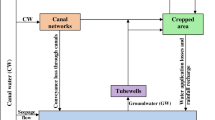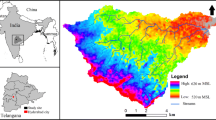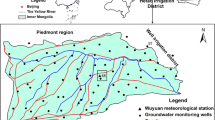Abstract
The advancement of irrigated agriculture is indispensable to satisfy the growing food demands of the escalating worldwide population. It is also essential for accomplishing many of the UN’s sustainable development goals (SDG) such as SDG1 (no poverty), SDG2 (zero hunger), SDG3 (good health and well-being), and SDG15 (life on land). However, without proper management, irrigation development can cause twin hydrological problems, i.e., rising groundwater level and salinization in irrigated regions. Long-term groundwater recharge estimation is essential for managing the above-mentioned problems of irrigated regions. This study formulated and employed a simple groundwater recharge model, which is a combination of the groundwater budget and seasonal groundwater level fluctuations. Estimated long-term (44 years, from 1976 to 2020) seasonal groundwater recharge was analyzed to appraise the twin hydrological problems of a study area in northwest India. The investigation is the first in the study region; it is simple to follow and it can be replicated in other regions of the world dealing with comparative issues. The analysis disclosed that the developed model performed very well in estimating groundwater recharge. This was verified statistically by high R-squared (0.987) and model efficiency (0.940) values and low mean error (0.011 m) and root-mean-square error (0.089 m) values. Analysis of various components of groundwater recharge revealed that more than 60% of the mean monsoonal recharge was provided by percolation alone due to the high paddy field portion. Higher average seasonal tubewell draft in the winter season always resulted in negative net recharge. However, yearly net recharge was consistently positive on account of higher monsoonal recharge. Consequently, the aquifer level rose at a mean rate of about 0.12 m annually throughout the study period. Because the groundwater level was already high, an additional rise would worsen the condition. Alternative management plans must be developed and realized for sustainable resource management in the region. As a follow-up action, three possible scenarios were investigated by using the model. The analysis of the scenarios disclosed that conjunctive water utilization needed to be increased for crop irrigation, which aids more groundwater withdrawal from the area. The other scenario suggested altered cropping with the reduced paddy cultivation because the paddy field contributed un-proportionately high recharge in the overall water balance of the region. The analysis suggested that implementing a combination of more than one change altogether would be more beneficial as compared to individual changes in baseline inputs. For example, altered cropping along with conjunctive water utilization would deliver more favorable results. The strategies described here are reliable in encouraging stakeholders/farmers to realize long-term sustainable goals.








Similar content being viewed by others
References
Ahmed, I., & Umar, R. (2008). Hydrogeological framework and water balance studies in parts of Krishni-Yamuna interstream area, Western Uttar Pradesh, India. Environmental Geology, 53, 1723–1730.
Ahmed, N., Hoque, M. A., Pradhan, B., & Arabameri, A. (2021). Spatio-temporal assessment of groundwater potential zone in the drought-prone area of Bangladesh using GIS-based bivariate models. Natural Resources Research. https://doi.org/10.1007/s11053-021-09870-0
Al-Abadi, A. M., Handhal, A. M., & Al-Ginamy, M. A. (2020). Evaluating the Dibdibba aquifer productivity at the Karbala-Najaf plateau (Central Iraq) using GIS-based tree machine learning algorithms. Natural Resources Research, 29(3), 1989–2009.
Allen, R. G., Pereira, L. S., Raes, D., & Smith, M. (1998). Guidelines for computing crop water requirements. Irrigation and Drainage Paper 56, FAO, Rome, Italy (p. 300).
Baalousha, H. M., Barth, N., Ramasomanana, F. H., & Ahzi, S. (2018). Groundwater recharge estimation and its spatial distribution in arid regions using GIS: A case study from Qatar karst aquifer. Modeling Earth Systems and Environment, 4(4), 1319–1329.
Chen, H., Huo, Z., Zhang, L., & White, I. (2020). New perspective about application of extended Budyko formula in arid irrigation district with shallow groundwater. Journal of Hydrology, 582, 124496.
Crosbie, R. S., Doble, R. C., Turnadge, C., & Taylor, A. R. (2019). Constraining the magnitude and uncertainty of specific yield for use in the water table fluctuation method of estimating recharge. Water Resources Research, 55, 7343–7361.
Cuthbert, M. O., Acworth, R. I., Andersen, M. S., Larsen, J. R., McCallum, A. M., Rau, G. C., & Tellam, J. H. (2016). Understanding and quantifying focused, indirect groundwater recharge from ephemeral streams using water table fluctuations. Water Resources Research, 52(2), 827–840.
Dadgar, M. A., Nakhaei, M., Porhemmat, J., Eliasi, B., & Biswas, A. (2020). Potential groundwater recharge from deep drainage of irrigation water. Science of the Total Environment, 716, 137105.
Dafny, E., & Simunek, J. (2016). Infiltration in layered loessial deposits: Revised numerical simulations and recharge assessment. Journal of Hydrology, 538, 339–354.
Dastane, N. G. (1978). Effective rainfall in irrigated agriculture. Irrigation and Drainage Paper 25, FAO, Rome, Italy (p. 62).
FAO. (2014). FAO statistical yearbook 2013, world food and agriculture. Food and Agriculture Organization of the United Nations, Rome (p. 289). Retrieved January 24, 2015, from http://www.fao.org/docrep/018/i3107e/i3107e00.htm.
Gemitzi, A., Ajami, H., & Richnow, H. H. (2017). Developing empirical monthly groundwater recharge equations based on modeling and remote sensing data-modeling future groundwater recharge to predict potential climate change impacts. Journal of Hydrology, 546, 1–13.
Gong, C., Zhang, Z., Wang, W., Duan, L., & Wang, Z. (2021). An assessment of different methods to determine specific yield for estimating groundwater recharge using lysimeters. Science of the Total Environment, 788, 147799.
Groundwater Cell. (2018a). Aquifer Atlas of Rohtak District. Department of Agriculture, Rohtak (Haryana), India.
Groundwater Cell. (2018b). Tubewells discharge atlas of Rohtak District. Department of Agriculture, Rohtak (Haryana), India.
Groundwater Estimation Committee. (1984). Norms for groundwater assessment. National Bank for Agriculture and Rural Development, Mumbai, India.
Hargreaves, G. H., & Samani, Z. A. (1985). Reference crop evapotranspiration from temperature. Applied Engineering in Agriculture ASABE, 1(2), 96–99.
Hassan, G. Z., & Bhutta, M. N. (1996). A water balance model to estimate groundwater recharge in Rechna doab, Pakistan. Irrigation and Drainage Systems, 10, 297–317.
Healy, R. W., & Cook, P. G. (2002). Using groundwater levels to estimate recharge. Hydrogeology Journal, 10(1), 91–109.
Hernandez-Sanchez, R. I., Castellanos, F., Herrera-Barrientos, J., & Belmonte-Jimenez, S. I. (2021). Gravimetric determination of storage coefficient and storage change of groundwater in an uncontrolled and unconfined aquifer. Natural Resources Research. https://doi.org/10.1007/s11053-021-09904-7
Huang, T., Pang, Z., Yang, S., & Yin, L. (2020). Impact of afforestation on atmospheric recharge to groundwater in a semiarid area. Journal of Geophysical Research: Atmospheres, 125(9), e2019JD032185.
Hung, V. V., & Broder, J. M. (2019). Estimating groundwater recharge for Hanoi, Vietnam. Science of the Total Environment, 651, 1047–1057.
Irrigation Department. (2018). Canal Atlas of Rohtak District. Office of the Executive Engineer, Irrigation Department, Rohtak (Haryana), India.
Keesari, T., Roy, A., Mohokar, H., Pant, D., & Sinha, U. K. (2020). Characterization of mechanisms and processes controlling groundwater recharge and its quality in droughtprone region of central India (Buldhana, Maharashtra) using isotope hydrochemical and end-member mixing modeling. Natural Resources Research, 29(3), 1951–1973.
Koïta, M., Yonli, H. F., Soro, D. D., Dara, A. E., & Vouillamoz, J.-M. (2018). Groundwater storage change estimation using combination of Hydrogeophysical and groundwater table fluctuation methods in hard rock aquifers. Resources, 7, 5.
Labrecque, G., Chesnaux, R., & Boucher, M.-A. (2020). Water-table fluctuation method for assessing aquifer recharge: Application to Canadian aquifers and comparison with other methods. Hydrogeology Journal, 28, 521–533.
Lv, M., Xu, Z., Yang, Z.-L., Lu, H., & Lv, M. (2021). A comprehensive review of specific yield in land surface and groundwater studies. Journal of Advances in Modeling Earth Systems, 13(2), e2020MS002270.
Manasa, M. R. K., Katukuri, N. R., Nair, S. S. D., Haojie, Y., & Yanga, Z. (2020). Role of biochar and organic substrates in enhancing the functional characteristics and microbial community in a saline soil. Journal of Environmental Management, 269, 110737.
Meinzer, O. E. (1923). The occurrence of groundwater in the united states with a discussion of principles. Chicago: University of Chicago.
Merchan, D., Sanz, L., Alfaro, A., Perez, I., Goni, M., Solsona, F., & Hernández-García, I. (2020). Irrigation implementation promotes increases in salinity and nitrate concentration in the lower reaches of the Cidacos River (Navarre, Spain). Science of the Total Environment, 706, 135701.
Misstear, B. D. R., Brown, L., & Johnston, P. M. (2008). Estimation of groundwater recharge in a major sand and gravel aquifer in Ireland using multiple approaches. Hydrogeology Journal, 17, 693–706.
Phondani, P. C., Bhatt, A., Elsarrag, E., Alhorr, Y. M., & El-Keblawy, A. (2016). Criteria and indicator approach of global sustainability assessment system for sustainable landscaping using native plants in Qatar. Ecological Indicators, 69, 381–389.
Rama, F., Miotlinski, K., Franco, D., & Corseuil, H. X. (2018). Recharge estimation from discrete water-table datasets in a coastal shallow aquifer in a humid subtropical climate. Hydrogeology Journal, 26, 1887–1902.
Reberski, J. L., Rubinic, J., Terzic, J., & Radisic, M. (2020). Climate change impacts on groundwater resources in the coastal Karstic Adriatic area: a case study from the Dinaric Karst. Natural Resources Research, 29(3), 1975–1988.
Risser, D. W., Gburek, W. J., & Folmar, G. J. (2009). Comparison of recharge estimates at a small watershed in east-central Pennsylvania, USA. Hydrogeology Journal, 17, 287–298.
Sameen, M. I., Pradhan, B., & Lee, S. (2019). Self-learning random forests model for mapping groundwater yield in data-scarce areas. Natural Resources Research, 28(3), 757–775.
Santarosa, L. V., Gastmans, D., Sitolini, T. P., Kirchheim, R. E., Betancur, S. B., Marcelo, E., Dias de Oliveira, M. E., & Campos, J. C. V. (2021). Assessment of groundwater recharge along the Guarani aquifer system outcrop zone in São Paulo State (Brazil): An important tool towards integrated management. Environmental Earth Sciences. https://doi.org/10.1007/s12665-021-09382-3
Scanlon, B. R., Healy, R. W., & Cook, P. G. (2002). Choosing appropriate techniques for quantifying groundwater recharge. Hydrogeology Journal, 10, 18–39.
Singh, A. (2012a). Validation of SaltMod for a semi-arid part of northwest India and some options for control of waterlogging. Agricultural Water Management, 115, 194–202.
Singh, A. (2012b). An overview of the optimization modelling applications. Journal of Hydrology, 466–467, 167–182.
Singh, A. (2016). Hydrological problems of water resources in irrigated agriculture: A management perspective. Journal of Hydrology, 541, 1430–1440.
Singh, A. (2018). Managing the salinization and drainage problems of irrigated areas through remote sensing and GIS techniques. Ecological Indicators, 89, 584–589.
Singh, A. (2019). Environmental problems of salinization and poor drainage in irrigated areas: Management through the mathematical models. Journal of Cleaner Production, 206, 572–579.
Singh, A. (2021a). A review of wastewater irrigation: Environmental implications. Resources, Conservation & Recycling, 168, 105454.
Singh, A. (2021b). Soil salinization management for sustainable development: A review. Journal of Environmental Management, 277, 111383.
Singh, A., Panda, S. N., Uzokwe, V. N. E., & Krause, P. (2019). An assessment of groundwater recharge estimation techniques for sustainable resource management. Groundwater for Sustainable Development, 9, 100218.
Sophocleous, M. (1985). The role of specific yield in ground-water recharge estimations: A numerical study. Ground Water, 23, 52–58.
Teramoto, E. H., & Chang, H. K. (2018). Métodos WTF e simulação numérica de fluxo para estimativa de recarga exemplo Aquífero Rio Claro em Paulínia. Águas Subterrâneas, 32, 173–180.
Tian, F., Hou, M., Qiu, Y., Zhang, T., & Yuan, Y. (2020). Salinity stress effects on transpiration and plant growth under different salinity soil levels based on thermal infrared remote (TIR) technique. Geoderma, 357, 113961.
Tyagi, N. K., Sharma, D. K., & Luthra, S. K. (2000). Evapotranspiration and crop coefficients: measurement and computation for crop water requirements. Bulletin No. 1/2000, Central Soil Salinity Research Institute, Karnal, India (p. 36).
United Nations (2019). United Nations, Introduction and proposed goals and targets on sustainable development for the post-2015 development agenda. Retrieved January, 24, 2020, from https://sustainabledevelopment.un.org/sdgs.
United Nations. (2020). World population prospects 2019: revision population database. Retrieved November 15, 2020, from https://population.un.org/wpp/.
Wei, Y., Ding, J., Yang, S., Wang, F., & Wang, C. (2021). Soil salinity prediction based on scale-dependent relationships with environmental variables by discrete wavelet transform in the Tarim Basin. CATENA, 196, 104939. https://doi.org/10.1016/j.catena.2020.104939
Wu, D., Jia, K., Zhang, X., Zhang, J., & El-Hamid, H. T. A. (2021). Remote sensing inversion for simulation of soil salinization based on hyperspectral data and ground analysis in Yinchuan, China. Natural Resources Research. https://doi.org/10.1007/s11053-021-09925-2
Xie, Y., Crosbie, R., Simmons, C. T., Cook, P. G., & Zhang, L. (2018). Uncertainty assessment of spatial-scale groundwater recharge estimated from unsaturated flow modelling. Hydrogeology Journal, 27, 379–393.
Xu, Y., & Beekman, H. E. (2019). Review: Groundwater recharge estimation in arid and semiarid southern Africa. Hydrogeology Journal, 27, 929–943.
Zhang, J., Wang, W., Wang, X., Yin, L., Zhu, L., Sun, F., Dong, J., Xie, Y., & Robinson, N. I. (2019). Seasonal variation in the precipitation recharge coefficient for the Ordos Plateau, Northwest China. Hydrogeology Journal, 27, 801–813.
Zhang, Z., Wang, W., Gong, C., & Zhang, M. (2020). A comparison of methods to estimate groundwater recharge from bare soil based on data observed by a large-scale lysimeter. Hydrological Processes, 34, 2987–2999.
Zhou, Z., Wang, C., Bi, J., Zhao, Y., & Xiang, W. (2021). Simulation of underground freshwater exploitation and analysis of environmental impact in Hangzhou Bay New Area, China. Natural Resources Research. https://doi.org/10.1007/s11053-020-09808-y
Zhu, R., Croke, B. F. W., & Jakeman, A. J. (2020). Diffuse groundwater recharge estimation confronting hydrological modelling uncertainty. Journal of Hydrology, 584, 124642.
Acknowledgments
The author communicates his genuine thanks to the Department of Agriculture, Irrigation Department, and Groundwater Cell (Rohtak), Survey of India (Dehradun) and India Meteorological Department (Pune) for providing the vital data to conduct this study. The author is particularly grateful to the Editor-in-Chief and the three anonymous reviewers for their valuable time and useful remarks, which have led to a notable enhancement to the early versions of the manuscript.
Author information
Authors and Affiliations
Corresponding author
Rights and permissions
About this article
Cite this article
Singh, A. Long-Term (44 Years) Regional Groundwater Recharge Estimation for Agricultural Sustainability. Nat Resour Res 31, 301–314 (2022). https://doi.org/10.1007/s11053-021-09981-8
Received:
Accepted:
Published:
Issue Date:
DOI: https://doi.org/10.1007/s11053-021-09981-8




